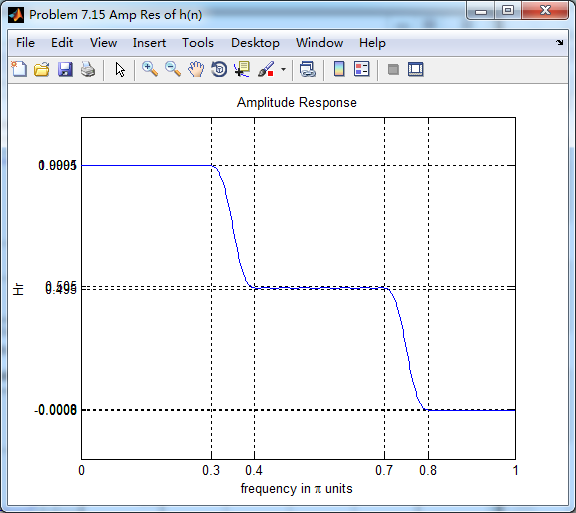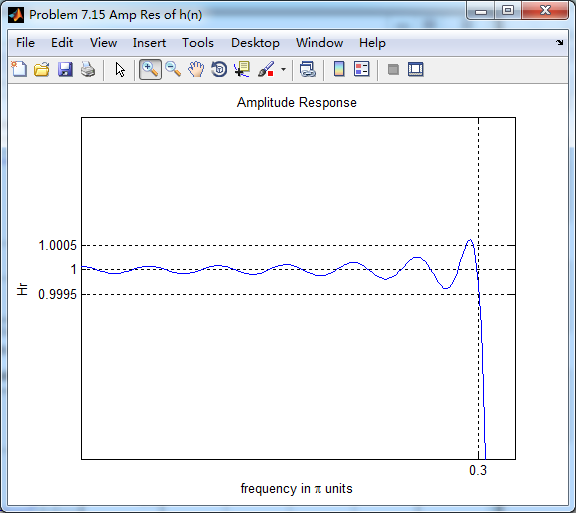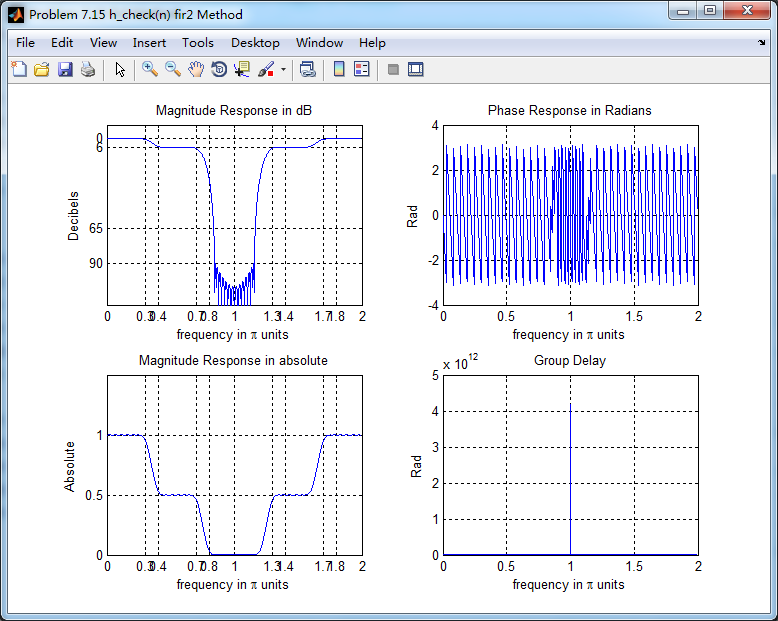《DSP using MATLAB》Problem 7.15

用Kaiser窗方法设计一个台阶状滤波器。
代码:
%% ++++++++++++++++++++++++++++++++++++++++++++++++++++++++++++++++++++++++++++++++
%% Output Info about this m-file
fprintf('\n***********************************************************\n');
fprintf(' <DSP using MATLAB> Problem 7.15 \n\n'); banner();
%% ++++++++++++++++++++++++++++++++++++++++++++++++++++++++++++++++++++++++++++++++ % staircase bandpass 3-Band
w1 = 0; w2 = 0.3*pi; delta1 = 0.01;
w3 = 0.4*pi; w4 = 0.7*pi; delta2 = 0.005;
w5 = 0.8*pi; w6 = pi; delta3 = 0.001; tr_width = min(w3-w2, w5-w3); f = [0 w2 w3 w4 w5 w6]/pi;
m = [1 1 0.5 0.5 0 0]; [Rp1, As1] = delta2db(delta1, delta3);
[Rp2, As2] = delta2db(delta2, delta3);
As = min(As1, As2) M = ceil((As-7.95)/(2.285*tr_width)) + 1; % Kaiser Window Length if As > 21 || As < 50
beta = 0.5842*(As-21)^0.4 + 0.07886*(As-21);
else
beta = 0.1102*(As-8.7);
end fprintf('\nKaiser Window method, Filter Length: M = %d. beta = %.4f\n', M, beta); n = [0:1:M-1]; wc1 = (w2+w3)/2; wc2 = (w4+w5)/2; %wc = (ws + wp)/2, % ideal LPF cutoff frequency hd = ideal_lp(wc1, M) + 0.5*(ideal_lp(wc2, M) - ideal_lp(wc1, M));
w_kai = (kaiser(M, beta))'; h = hd .* w_kai;
[db, mag, pha, grd, w] = freqz_m(h, [1]); delta_w = 2*pi/1000;
[Hr,ww,P,L] = ampl_res(h); Rp1 = -(min(db(1 :1: w2/delta_w+1))); % Actual Passband Ripple
fprintf('\nActual Passband Ripple1 is %.4f dB.\n', Rp1); Rp2 = -(min(db(w3/delta_w+1 :1: w4/delta_w+1))); % Actual Passband Ripple
fprintf('\nActual Passband Ripple2 is %.4f dB.\n', Rp2); As = -round(max(db(floor(w5/delta_w)+1 : 1 : floor(w6/delta_w)+1 ))); % Min Stopband attenuation
fprintf('\nMin Stopband attenuation is %.4f dB.\n', As); [delta1, delta3] = db2delta(Rp1, As)
[delta2, delta3] = db2delta(Rp2, As) % Plot figure('NumberTitle', 'off', 'Name', 'Problem 7.15 ideal_lp Method')
set(gcf,'Color','white'); subplot(2,2,1); stem(n, hd); axis([0 M-1 -0.3 0.5]); grid on;
xlabel('n'); ylabel('hd(n)'); title('Ideal Impulse Response'); subplot(2,2,2); stem(n, w_kai); axis([0 M-1 0 1.1]); grid on;
xlabel('n'); ylabel('w(n)'); title('Kaiser Window'); subplot(2,2,3); stem(n, h); axis([0 M-1 -0.3 0.5]); grid on;
xlabel('n'); ylabel('h(n)'); title('Actual Impulse Response'); subplot(2,2,4); plot(w/pi, db); axis([0 1 -120 10]); grid on;
set(gca,'YTickMode','manual','YTick',[-90,-65,-6,0]);
set(gca,'YTickLabelMode','manual','YTickLabel',['90';'65';' 6';' 0']);
set(gca,'XTickMode','manual','XTick',[f]);
xlabel('frequency in \pi units'); ylabel('Decibels'); title('Magnitude Response in dB'); figure('NumberTitle', 'off', 'Name', 'Problem 7.15 h(n) ideal_lp Method')
set(gcf,'Color','white'); subplot(2,2,1); plot(w/pi, db); grid on; axis([0 2 -120 10]);
xlabel('frequency in \pi units'); ylabel('Decibels'); title('Magnitude Response in dB');
set(gca,'YTickMode','manual','YTick',[-90,-65,-6,0])
set(gca,'YTickLabelMode','manual','YTickLabel',['90';'65';' 6';' 0']);
set(gca,'XTickMode','manual','XTick',[f,1+f(2:6)]); subplot(2,2,3); plot(w/pi, mag); grid on; %axis([0 2 -100 10]);
xlabel('frequency in \pi units'); ylabel('Absolute'); title('Magnitude Response in absolute');
set(gca,'XTickMode','manual','XTick',[f,1+f(2:6)]);
set(gca,'YTickMode','manual','YTick',[0,0.5, 1]) subplot(2,2,2); plot(w/pi, pha); grid on; %axis([0 1 -100 10]);
xlabel('frequency in \pi units'); ylabel('Rad'); title('Phase Response in Radians');
subplot(2,2,4); plot(w/pi, grd*pi/180); grid on; %axis([0 1 -100 10]);
xlabel('frequency in \pi units'); ylabel('Rad'); title('Group Delay'); figure('NumberTitle', 'off', 'Name', 'Problem 7.15 Amp Res of h(n)')
set(gcf,'Color','white'); plot(ww/pi, Hr); grid on; %axis([0 1 -100 10]);
xlabel('frequency in \pi units'); ylabel('Hr'); title('Amplitude Response');
set(gca,'YTickMode','manual','YTick',[-delta3,0,delta3,0.5-0.005, 0.5+0.005,1-delta1,1,1+delta1])
%set(gca,'YTickLabelMode','manual','YTickLabel',['90';'45';' 0']);
set(gca,'XTickMode','manual','XTick',[f,2]); %% +++++++++++++++++++++++++++++++++++++++++++++++++
%% fir2 function method
%% +++++++++++++++++++++++++++++++++++++++++++++++++
f = [w1, w2, w3, w4, w5, w6]/pi;
m = [1 1 0.5 0.5 0 0];
ripple = [0.01 0.005 0.001]; fprintf('\n--------- use fir2 function ---------\n'); h_check = fir2(M-1, f, m, kaiser(M, beta)); [db, mag, pha, grd, w] = freqz_m(h_check, [1]);
%[Hr,ww,P,L] = ampl_res(h_check);
[Hr,ww,P,L] = Hr_Type2(h_check); %% -------------------------------------------
%% plot
%% -------------------------------------------
figure('NumberTitle', 'off', 'Name', 'Problem 7.15 fir2 Method')
set(gcf,'Color','white'); subplot(2,2,1); stem(n, hd); axis([0 M-1 -0.3 0.5]); grid on;
xlabel('n'); ylabel('hd(n)'); title('Ideal Impulse Response'); subplot(2,2,2); stem(n, w_kai); axis([0 M-1 0 1.1]); grid on;
xlabel('n'); ylabel('w(n)'); title('Kaiser Window'); subplot(2,2,3); stem([0:M-1], h_check); axis([0 M -0.3 0.5]); grid on;
set(gca,'XTickMode','manual','XTick',[0 M/2 M]);
xlabel('n'); ylabel('h\_check(n)'); title('Actual Impulse Response'); subplot(2,2,4); plot(w/pi, db); axis([0 1 -120 10]); grid on;
set(gca,'YTickMode','manual','YTick',[-90,-65,-6,0]);
set(gca,'YTickLabelMode','manual','YTickLabel',['90';'65';' 6';' 0']);
set(gca,'XTickMode','manual','XTick',[f]);
xlabel('frequency in \pi units'); ylabel('Decibels'); title('Magnitude Response in dB'); figure('NumberTitle', 'off', 'Name', 'Problem 7.15 h_check(n) fir2 Method')
set(gcf,'Color','white'); subplot(2,2,1); plot(w/pi, db); grid on; axis([0 2 -120 10]);
xlabel('frequency in \pi units'); ylabel('Decibels'); title('Magnitude Response in dB');
set(gca,'YTickMode','manual','YTick',[-90,-65,-6,0])
set(gca,'YTickLabelMode','manual','YTickLabel',['90';'65';' 6';' 0']);
set(gca,'XTickMode','manual','XTick',[f,1+f(2:6)]); subplot(2,2,3); plot(w/pi, mag); grid on; %axis([0 2 -100 10]);
xlabel('frequency in \pi units'); ylabel('Absolute'); title('Magnitude Response in absolute');
set(gca,'XTickMode','manual','XTick',[f,1+f(2:6)]);
set(gca,'YTickMode','manual','YTick',[0,0.5, 1]) subplot(2,2,2); plot(w/pi, pha); grid on; %axis([0 1 -100 10]);
xlabel('frequency in \pi units'); ylabel('Rad'); title('Phase Response in Radians');
subplot(2,2,4); plot(w/pi, grd*pi/180); grid on; %axis([0 1 -100 10]);
xlabel('frequency in \pi units'); ylabel('Rad'); title('Group Delay');
运行结果:
Kaiser窗长M=74,两个通带衰减分别为0.0079dB和6.0345dB,阻带最小衰减65dB>60dB,满足设计要求。

用理想低通滤波方法设计的结果,实际脉冲响应、幅度谱(dB单位)

幅度谱(dB和绝对单位)、相位谱和群延迟响应

振幅响应(台阶状)

第一个台阶(通带)

第二个台阶(通带)

阻带

题目中暗示可以用fir1函数,但查了帮助和网上资料还是不会,只好用fir2函数的方法来设计,结果如下:


群延迟不是严格的常数了,非线性相位滤波器。
《DSP using MATLAB》Problem 7.15的更多相关文章
- 《DSP using MATLAB》Problem 6.15
代码: %% ++++++++++++++++++++++++++++++++++++++++++++++++++++++++++++++++++++++++++++++++ %% Output In ...
- 《DSP using MATLAB》Problem 5.15
代码: %% ++++++++++++++++++++++++++++++++++++++++++++++++++++++++++++++++++++++++++++++++ %% Output In ...
- 《DSP using MATLAB》Problem 4.15
只会做前两个, 代码: %% ---------------------------------------------------------------------------- %% Outpu ...
- 《DSP using MATLAB》Problem 2.15
代码: %% ------------------------------------------------------------------------ %% Output Info about ...
- 《DSP using MATLAB》Problem 8.15
代码: %% ------------------------------------------------------------------------ %% Output Info about ...
- 《DSP using MATLAB》Problem 5.38
代码: %% ++++++++++++++++++++++++++++++++++++++++++++++++++++++++++++++++++++++++++++++++ %% Output In ...
- 《DSP using MATLAB》Problem 5.31
第3小题: 代码: %% ++++++++++++++++++++++++++++++++++++++++++++++++++++++++++++++++++++++++++++++++ %% Out ...
- 《DSP using MATLAB》Problem 5.22
代码: %% ++++++++++++++++++++++++++++++++++++++++++++++++++++++++++++++++++++++++++++++++++++++++ %% O ...
- 《DSP using MATLAB》Problem 5.21
证明: 代码: %% ++++++++++++++++++++++++++++++++++++++++++++++++++++++++++++++++++++++++++++++++++++++++ ...
随机推荐
- mybatis调用存储过程,获取返回的游标
将调用存储过程参数放入map中,由于返回的游标中包含很多参数,所以再写一个resultmap与之对应,类型为hashmap.设置返回的jdbcType=CURSOR,resultMap设置为id对应的 ...
- myBatis xml if、where、if-else?、foreach 心得
MyBatis 的强大特性之一便是它的动态 SQL.如果你有使用 JDBC 或其它类似框架的经验,你就能体会到根据不同条件拼接 SQL 语句的痛苦.例如拼接时要确保不能忘记添加必要的空格,还要注意去掉 ...
- HFun.快速开发平台(二)=》自定义列表实例
应用系统中数据列表的展现是开发内容之一,实现的方式基本是通过编号具体的访问列表页实现,通过检索条件进行数据源的获取,列字段的描述,还可能会有检索条件的实现,列表数据的导出等功能. 为了将重复工作进行简 ...
- d3js可视化策略
d3js是数据驱动图形的思路.基本可以这么理解,有什么样的图形,后面基本就有类似结构的数据.大概思路步骤如下: 一.适配数据格式 这一步主要是为第二部服务,第一步的结果作为第二部的入参. 比如,画层级 ...
- python的切片
切片 取一个list或tuple的部分元素是非常常见的操作.比如,一个list如下: >>> L = ['Michael', 'Sarah', 'Tracy', 'Bob', 'Ja ...
- 使用python进行24bit音频处理
import struct # datalike=b'\x00\x00\x02\xff\xff\xff' #b'\xff\xff\xff\xff\xff\xff' import audioop cla ...
- 淘宝的推荐系统 计算之道2A
小明刚刚入职淘宝,老大给他交代了一个简单的任务,实现一个简易的商品推荐系统. 这个商品推荐系统的需求如下: 一共有 n 件商品可以被推荐,他们的编号分别为 1 到 n.每件商品都有一个价格,编号为 i ...
- vue生命周期和钩子函数
new Vue 创建vue实例 init events & liftcycle 开始初始化 beforeCreate 组件刚被创建,组件属性计算之前,如data属性等 init injecti ...
- 网络协议中HTTP,TCP,UDP,Socket,WebSocket的优缺点/区别
先说一下网络的层级:由下往上分为 物理层.数据链路层.网络层.传输层.会话层.表示层和应用层 1.TCP和UDP TCP:是面向连接的一种传输控制协议.属于传输层协议.TCP连接之后,客户端和服务器可 ...
- kaptcha生成java验证码
kaptcha工作的原理是调用 com.google.code.kaptcha.servlet.KaptchaServlet,生成一个图片.同时将生成的验证码字符串放到 HttpSession中. 1 ...
